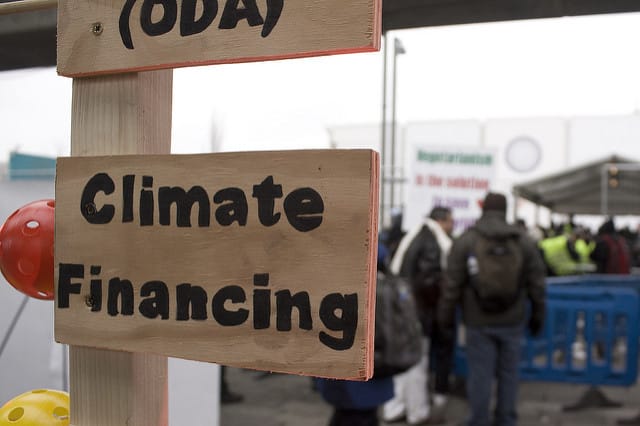
Patricia Espinosa, Executive Secretary of the United Nations Framework Convention on Climate Change (UNFCCC) reminded us earlier this year that in order to avoid dangerous interference with the climate system we need to do (at least) three things: implement Nationally Determined Contributions (NDCs), strengthen the economic case for climate action and align international finance with sustainability and climate goals.
As regards the latter, decisive climate action depends on a full transformation of social and economic models towards a low carbon economy. This will require mobilising significant amounts of climate finance in the near future if we want to have a likely chance of limiting global mean temperature increases to well below 2ºC.
Climate finance has no agreed definition to date. And, what is hard to define can lend itself to fuzzy conceptualisations, making it difficult to measure, recognise and, more importantly for climate action, scale up sufficiently. A broad definition of climate finance includes all sources of funding, public and private, for all types of projects, aimed at mitigating greenhouse gas emissions and adapting to the adverse consequences of climate change, worldwide. However, not everyone agrees on this definition; a few months ago, Bruce Usher (Columbia Business School) stated that he understood climate finance to be funds allocated to mitigation projects, leaving out adaptation finance. Another, narrower definition, would limit climate finance to that which UNFCCC Parties mobilised, or pledged to disburse in the future.
Commitments to mobilise international climate finance under the narrow definition included in the Paris Agreement amount to US$100 billion annually from 2020 to 2025, and a revision using the US$100 billion floor from 2025 onwards. The amount of climate finance mobilised to date has been hotly debated. Institutions such as the OECD and Climate Policy Initiative (CPI) claim that climate funds from developed to developing countries reached US$62 billion in 2014. This figure was heavily criticised by developing countries such as Brazil, China, India and South Africa for double counting some of the climate finance mobilised by developed countries and for undertaking the analysis without consulting developing countries.
According to the broader definition of climate finance, CPI’s conservative estimates on global climate finance amounts to US$3921 billion invested in low-carbon growth in 2014, an increase of 18% compared to the previous year. In terms of the public-private split of funds, 39% was public money, making the private sector the key driver of climate investments with the remaining 61% of global climate finance flows. Geographically, 30% of the funds were invested in East Asia and the Pacific (with 21% of total finance invested in China), 25% in Western Europe, 11% in the Americas, 10% in Japan, Korea and Israel, and 7% in Latin America and the Caribbean.
Whereas this amount is significant there is a sizeable investment gap to ensure that NDCs are implemented. The International Energy Agency (IEA) estimates that the investment needs to comply with NDCs commitments to 2030, only in the energy efficiency and low carbon technology areas, are US$ 13.5 trillion (US$ 840 billion annually on average from 2015 to 2030). A further 3.5 trillion is additionally needed for a 2ºC pathway. The gap for remaining below 2ºC is therefore in the trillion mark globally per annum.
The dramatic drop in the cost of renewables, the low average long-term interest rates (which according to OECD data has fluctuated between 0% and 4% over the last five years) and the attractive return on wind and solar projects pushed renewable investments up to US$ 285 billions globally in 2015, significantly above additional fossil fuel investment. But, this is not enough for ensuring a transition to a low carbon economy.
There are various factors that are holding back climate finance. These include: higher perceived risks associated with low carbon technologies, uncertain regulatory environments (the single most important element hampering low carbon investment), returns on renewables projects not being attractive enough to offset the higher perceived risk of climate investments, higher capital expenditures (and related higher financial costs) and low liquidity of renewable investments compared to high carbon investments. Contextual factors such as the economic crisis of 2008 and the macroeconomic policies that followed have been an obstacle to scaling of climate finance. These factors led to: fiscal and budgetary constraints with, for example, feed-in tariffs being cut; macroprudential regulation entailing more liquidity and capital requirements that penalise low carbon investments; and, monetary policy being currently biased against low carbon investment with green bonds representing a growing but small share of the bond market.2
As regards what can be done to nudge the economy towards a low carbon development pathway, pricing carbon is the first resort that comes to mind due to its static and dynamic efficiency properties. However, pricing might not be feasible (or sufficient) to ensure climate finance flows towards low carbon investments in adequate amounts to ensure the well-below 2ºC goal is met.
So, according to Campiglio, in order to foster a ‘quick’ and smooth transition to a low carbon economy a triple alignment of institutions, actors and policies should be forthcoming, if we agree that climate change can be considered as a systemic risk for the economy. First, economic policy (fiscal3, macroprudential4 and monetary5) and climate policy alignment should occur. Second, institutional alignment is desirable between climate change departments and the rest of ministries and departments, especially in economic and financial areas. Lastly, social alignment of firms, public institutions, banks and the financial sector should be sought. The materialisation of this triple alignment would mean climate variables are integrated across policies, institutions and actors within society. Climate Policy Integration seems to be an imperative if we intend to avoid dangerous interference with the climate system and its related potential systemic risks.
Climate-related financial risks are not yet fully known however as companies are not used to disclosing such risks and the financial sector is not fully aware of how exposed their portfolios are to climate risks. To tackle these information shortcomings, Mark Carney’s and Michael Bloomberg’s Task Force on Climate-related Financial Disclosures (TCFD) released, in December 2016, a draft report that provides voluntary guidelines regarding how companies should disclose their exposure to climate risks and their climate risk management strategies under several scenarios (including a 2ºC scenario). The goal of these disclosures is to provide investors with information to limit their exposure to physical and transition climate-related risks.
As regards public initiatives to tackle the lack of information regarding exposure to climate risks, the French Energy Transition Law in its article 173 requires listed companies to disclose climate related risks as well as climate risk-related management strategies. Additionally, banks are to conduct climate change related stress testing and institutional investors are to disclose their Environmental, Social and Governance strategies. These (or similar) information requirements could be included in other laws, including the forthcoming Climate Change and Energy Transition Law in Spain, in order to enable better investment choices.
1 Note that UNFCCC estimates included in the Sixth Biennial Assessment Report by the Standing Committee on Climate Finance builds on the CPI data and is broader in scope, stating global climate finance amounts to US$714 billion on average in 2013-2014.
2 Depending on the source, the share of Green bonds compared to the global bond market, ranges from 0.1% to 0.7%, the latter figure considering ‘green aligned bonds’ which includes green labelled bonds and non labelled green bonds that finance climate related assets.
3 For example taking advantage of relatively moderate (and stable) oil prices to remove fossil fuel subsidies that go against internalising the price of CO2.
4 A climate-macroprudential policy alignment would include green differentiated reserve and capital requirements as well as the inclusion of environmental, social and governance criteria in risk analyses.
5 Climate and monetary policy alignment would amount to greening monetary policy, meaning that central banks would be fostering green investments.


